Raised bed soil and potting soil are both essential components for successful gardening, but they serve different purposes and are not interchangeable. Understanding the differences between these two types of soil can help you make informed decisions when planning your garden. In this article, we will explore the distinctions between raised bed soil and potting soil, their uses, benefits, and practical tips for optimizing their performance.
Raised Bed Soil
Raised bed soil is specifically designed for use in raised garden beds. These beds are typically constructed from wood, stone, or other materials and are filled with a mixture of soil, compost, and organic matter. Raised bed soil is formulated to provide optimal drainage, aeration, and nutrients for plants to thrive in a contained environment.
Key Characteristics of Raised Bed Soil:
- Rich in organic matter: Raised bed soil is typically a blend of topsoil, compost, peat moss, and other organic materials that provide essential nutrients for plant growth.
- Well-draining: Raised bed soil is designed to prevent waterlogging, which can lead to root rot and other moisture-related issues.
- Loose and friable: The soil in raised beds is light and fluffy, making it easy for plant roots to penetrate and access nutrients.
- pH-balanced: Raised bed soil is usually pre-balanced to ensure optimal pH levels for plant growth.
Potting Soil
Potting soil, on the other hand, is a versatile growing medium used in container gardening. It is specifically formulated to provide plants with the necessary nutrients, moisture retention, and aeration in the confined space of a pot or container. Potting soil is available in various blends tailored to specific plant types, such as cacti, succulents, or flowering plants.
Key Characteristics of Potting Soil:
- Lightweight: Potting soil is designed to be lightweight for ease of handling and transportation.
- Moisture-retentive: Potting soil contains materials like peat moss and vermiculite to help retain moisture in container plants.
- Nutrient-rich: Potting soil is enriched with nutrients like nitrogen, phosphorus, and potassium, essential for plant growth.
- pH-balanced: Potting soil is often pH-adjusted to suit different plant preferences.
Key Differences between Raised Bed Soil and Potting Soil:
-
Container vs. Garden Beds:
- Potting soil is for use in containers, while raised bed soil is for raised garden beds.
-
Composition:
- Raised bed soil contains a mixture of topsoil, compost, and other organic matter, while potting soil may contain materials like peat moss, vermiculite, and perlite.
-
Drainage and Aeration:
- Raised bed soil is designed for optimal drainage and aeration in garden beds, while potting soil is formulated for containers with limited drainage.
-
Nutrient Levels:
- Raised bed soil may require additional fertilization over time, while potting soil is usually enriched with nutrients for immediate plant use.
Benefits of Raised Bed Soil and Potting Soil:
-
Raised Bed Soil:
- Improved root development
- Reduced soil compaction
- Better water retention
- Enhanced nutrient availability
-
Potting Soil:
- Versatility for various plant types
- Lightweight and easy to handle
- Reduced risk of soil-borne diseases
- Convenient for indoor and outdoor planting
Practical Tips for Using Raised Bed Soil and Potting Soil:
- Regularly amend raised bed soil with compost or organic matter to replenish nutrients.
- Ensure proper drainage in raised beds by adding gravel or sand at the bottom.
- Choose the right potting soil blend for each plant type to promote healthy growth.
- Monitor moisture levels in container plants to prevent overwatering or underwatering.
Conclusion:
In conclusion, raised bed soil and potting soil are indispensable components for successful gardening, each tailored to specific growing conditions and requirements. By understanding the differences between these two types of soil and their unique characteristics, you can optimize plant growth and yield in your garden or container plants. Whether you are cultivating a vegetable garden in raised beds or tending to houseplants in pots, selecting the right soil blend is essential for the health and vitality of your plants. Remember to choose high-quality soil, amend it as needed, and provide proper care to enjoy a thriving garden year-round.
